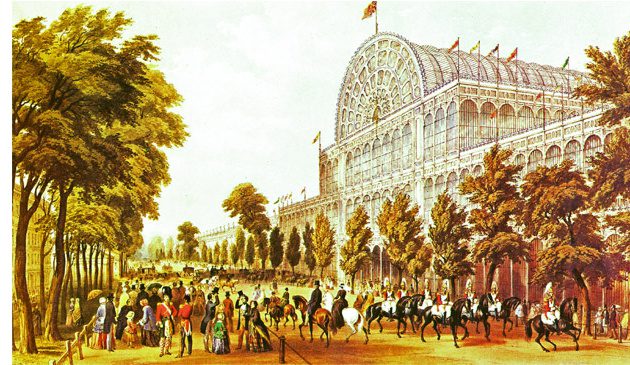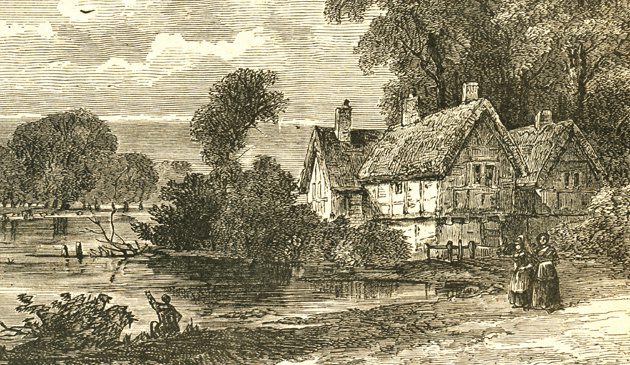St. James’s Park and Green Park – the making of the modern parks

The Temple of Peace in Green Park looking from the viewpoint of St. James’s Palace. It was created for the celebrations to mark the peace settlement of Aix le Chapelle in 1748 following the end of the War of the Austrian Succession. On the left of this contemporary print stands Buckingham House, the future royal palace. Constitution Hill passes from Green Park into St. James’s Park through the gate on the left of the temple. Hyde Park is in the background. Above the temple a thirty feet diameter representation of the sun stands on a fifty feet high pole, which was planned to illuminate the proceedings. Handel composed ‘Music for Royal Fireworks’ for the event.
During his reign in the 16th century Henry VIII created a large hunting park from different pieces of land. These evolved over the centuries into a series of large royal parks that are open to the public, which dominate the west side of Central London. The modern St. James’s Park and Green Parks were largely created during the 18th and early 19th centuries.
To form his hunting ground Henry confiscated the Manor of Hide from Westminster Abbey, which became Hyde Park and Kensington Gardens. At the same time the ownership of the leper hospice of St. James the Less, to the west of Henry’s Whitehall Palace, was transferred from Eton College. Henry replaced the hospice with St. James’s Palace, initially with a hunting lodge, and the surrounding land became St. James’s Park.
The part of St. James’s Park immediately west of Whitehall Palace was landscaped for Charles II. A long canal was created the length of the park. Along the north side a track named The Mall was created, with Birdcage Walk to the south.
Whitehall Palace was largely destroyed by fire in 1698. By then the main royal residence was at Kensington Palace on the west side of Hyde Park. At the beginning of the 18th century the Duke of Buckingham had the former Arlington House rebuilt on the western edge of St. James’s Park, close to St. James’s Palace, facing directly along The Mall.
Queen Caroline, wife of George II, who was making great changes to Hyde Park, also turned her attention to Upper St. James’s Park, the modern Green Park, which was still little more than a meadow. She created a path along the eastern side, which is still known as Queen’s Walk, and a library in a pavilion where she spent time after her daily promenade. A reservoir called the Queen’s Basin was formed alongside Piccadilly to supply water to St. James’s Palace and Buckingham House. The reservoir subsequently became part of the supply system of the Chelsea water company and at that time held 1,500,000 gallons.
Britain was at war for eight years as part of the War of the Austrian Succession, during which George’s territory of Hanover was vulnerable and even Britain was under threat of attack. The conflict ended in 1748 and to mark the occasion a grand event was organised in Upper St. James’s Park a year later, on the first anniversary. The Italian theatrical architect Giovanni Niccolò Servandoni was commissioned to create a Temple of Peace pavilion, 410 feet long and 114 feet tall. Tens of thousands of fireworks were ordered from Ruggieri & Sarti of Bologna for a pyrotechnic display, and George Frideric Handel composed accompanying music. Jonathan Tyers, creator of the Vauxhall Pleasure Gardens took charge of illuminations. Special stands were erected for distinguished guests. The cost was £90,000. In the morning of the event the King inspected three regiments of Footguards under the command of the Duke of Cumberland. Twelve thousand people gathered to watch the spectacle. Music began as darkness fell and a hundred and one cannons were fired from Constitution Hill. However, part of the vast pavilion was set alight by a stray rocket and, while people scrambled to safety, most of the fireworks went off unnoticed. Three people died and the Queen’s library was destroyed.
The King had insisted that Handel should provide “martial music” for the event using brass, woodwind and percussion. The composer later re-worked his ‘Music for Royal Fireworks’ using strings, which is how it is performed today.
By the late 18th century Upper St. James’s Park was a common venue for duels. One notable occasion was in 1771 between the English soldier Viscount Ligonier and the Italian dramatist Count Alfieri. Alfieri was having an affair with Ligonier’s wife, Penelope Pitt. On learning this, Ligonier sought Alfieri and found him at the Haymarket Theatre where he sat in a box with the Spanish ambassador and his wife. Alfieri excused himself and he travelled to Green Park where he entered a swordfight with Ligonier. Alfieri received a wound to his arm. Ligonier considered that to be enough to satisfy his honour and left the scene. Alfieri returned to the theatre to watch the last act of the play. News quickly spread and Penelope hastened to bathe his wound.
Part of the land on which Buckingham House was built had originally been taken from St. James’s Park under lease from the Crown. That complication allowed George III to acquire the entire site in 1761 from the Dukes of Buckingham, including the house. The King wished to use Buckingham House as a family villa following his marriage to Queen Caroline of Mecklenburg, as well as somewhere for his growing library. St. James’s Palace was then too antiquated for a family home. The transformation of Buckingham House then began that would turn it into the palace of today. The state rooms of St. James’s Palace continued to be used for official business.
In 1767 part of Upper St. James’s Park was appropriated to enlarge the garden of Buckingham House. In around 1772 Rosamond’s Pond, which pre-dated Henry VIII’s hunting ground, was filled in. What remained of Upper St. James’s Park was renamed Green Park. During the following decades The Mall became less fashionable for the aristocracy to promenade, moving instead to Green Park. The walks in St. James’s Park were left in a state of disrepair.


